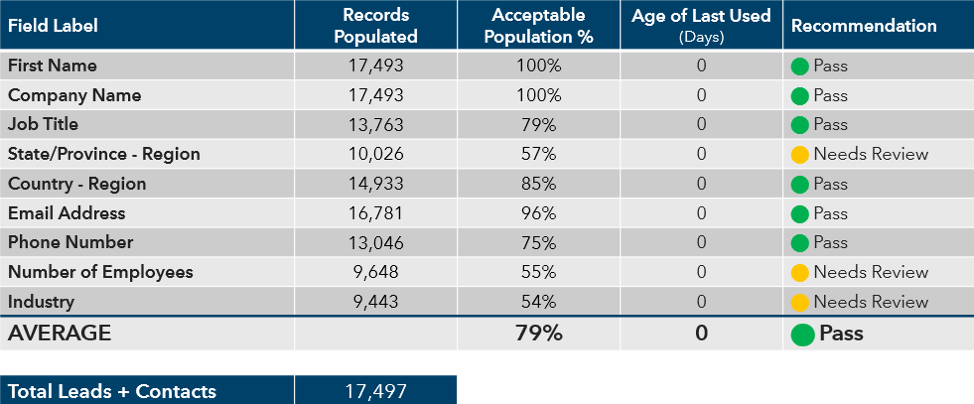
As marketers, we have access to more data points than we’ll ever really need. And yet, there’s always a case where we need to tightly segment a list, but we simply don’t have the data — even if we had it in the past.
That’s because it’s effectively impossible to maintain perfect data hygiene — by its very nature, account and contact data will degrade over time.
Establishing an Ideal Customer Profile Scorecard helps solve for this in three ways:
- Driving a documented, agreed-upon organizational and system definition of your Ideal Customer Profile (ICP),
- Pinpointing gaps in your data to provide focus on what needs to be fixed first, and
- Presenting a quantifiable way to benchmark and track the ongoing quality of your data.
Define your Ideal Customer Profile
First, bring together key stakeholders from your product, marketing, sales, and customer organizations to define in business terms what your Ideal Customer looks like. What size is the organization? What verticals do they serve? What technology do they use? What key business processes or methodologies do they employ? At the individual level, what job level and/or job function do they hold? And so on.
Further, you may have multiple ICPs or different segments within an ICP. For example, within an ICP, some accounts will still be prospects while others are already customers. You likely have additional criteria that are specific to only customers, such as products purchased or customer lifetime value.
Identify the data fields that align to your ICP
I recommend using this ICP blueprint to define how and where these characteristics are matched to your internal systems’ data points. For example, if your ICP is companies with over 500 employees, where is an account field for “Number of Employees” stored? If it’s in multiple systems, which is the gold standard? List these systems, tables, and fields in your Scorecard.
As you assess which fields to include, only keep those that you expect to require for segmentation, personalization, primary outbound contact methods, lead scoring, automated program logic, reporting, or other specific needs — try to limit yourself to about 20 fields per Scorecard.
An example of a high-level Ideal Customer Profile Scorecard might include the following fields:
- First Name
- Company Name
- Job Title
- State/Province
- Country
- Email Address
- Phone Number
- Number of Employees
- Industry
Ideally, all your Scorecard fields are available on both Lead records and Contact/Account records, if you’re using the Leads table to store records for your segment. This will enable you to score your contact data across the entire database.
Assess your data
Once you’ve finalized your list of fields, it’s time to perform an audit of your data. Here are some of the key metrics you should use:
- Percent of total records with any value (i.e. not blank)
- For picklist fields, percent of total records with an acceptable value
- Datestamp of most recent record created with any value in that field
Note that your audit should consider not only fields, but also entire records. You will want to define thresholds for Pass, Needs Review, or Fail at both levels. For example, your thresholds might be:
- Acceptable Population value for each field must be greater than 60% to pass
- Record must achieve a minimum of 60% Population on at least any 5 fields to pass
- Datestamp field of most recent record must be less than 180 days ago
Pull this information together to create your Scorecard, as in the example below:

Identify and address any gaps in your data
Now that you’ve audited the fields that makes up your Ideal Customer Profile, you can start to drill into the problem areas. In the above example, we’re potentially losing visibility into as much as 45% of our marketable database because we don’t have data for Number of Employees or Industry. Also, because we’re missing State/Province on over 40% of the records, our routing rules are potentially dropping leads into a black hole and the marketing team might not be effectively able to drive attendance at local, in-person events.
Track your progress
At the bottom of that sample Scorecard, you’ll see an “Average” calculation of each of the fields’ Acceptable Population Percentage. While this is a somewhat manufactured metric, it does provide a single, holistic measure that is easy to track over time. Once you begin to put initiatives in place to address the gaps you’ve identified, that Average metric is an easily consumed benchmark to capture and report.
If you need assistance with creating and filling in your Ideal Customer Profile Scorecard, DemandGen can help. Our comprehensive Data Audit includes this Scorecard, as well as analysis of your data for many other use cases critical for sales and marketing optimization. We also provide a number of other Data Services offerings. We’ll roll up our sleeves, dig into your data, and help you get it in healthy shape — with the numbers to prove it!
 Gaea Connary, Consultant at DemandGen, focuses on helping organizations strengthen their lead management processes, lead scoring, nurturing strategy, and reporting and analysis to get the best return on their technology investment and meet their marketing objectives.
Gaea Connary, Consultant at DemandGen, focuses on helping organizations strengthen their lead management processes, lead scoring, nurturing strategy, and reporting and analysis to get the best return on their technology investment and meet their marketing objectives.
The post How to Create an Ideal Customer Profile Scorecard to Find and Fix Critical Gaps in Your Data appeared first on DemandGen.
About the Author
More Content by DemandGen























